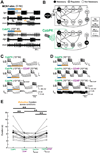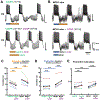Perturbation-specific responses by two neural circuits generating similar activity patterns
- PMID: 34506730
- PMCID: PMC8578407
- DOI: 10.1016/j.cub.2021.08.042
Perturbation-specific responses by two neural circuits generating similar activity patterns
Abstract
A fundamental question in neuroscience is whether neuronal circuits with variable circuit parameters that produce similar outputs respond comparably to equivalent perturbations.1-4 Work on the pyloric rhythm of the crustacean stomatogastric ganglion (STG) showed that highly variable sets of intrinsic and synaptic conductances can generate similar circuit activity patterns.5-9 Importantly, in response to physiologically relevant perturbations, these disparate circuit solutions can respond robustly and reliably,10-12 but when exposed to extreme perturbations the underlying circuit parameter differences produce diverse patterns of disrupted activity.7,12,13 In this example, the pyloric circuit is unchanged; only the conductance values vary. In contrast, the gastric mill rhythm in the STG can be generated by distinct circuits when activated by different modulatory neurons and/or neuropeptides.14-21 Generally, these distinct circuits produce different gastric mill rhythms. However, the rhythms driven by stimulating modulatory commissural neuron 1 (MCN1) and bath-applying CabPK (Cancer borealis pyrokinin) peptide generate comparable output patterns, despite having distinct circuits that use separate cellular and synaptic mechanisms.22-25 Here, we use these two gastric mill circuits to determine whether such circuits respond comparably when challenged with persisting (hormonal: CCAP) or acute (sensory: GPR neuron) metabotropic influences. Surprisingly, the hormone-mediated action separates these two rhythms despite activating the same ionic current in the same circuit neuron during both rhythms, whereas the sensory neuron evokes comparable responses despite acting via different synapses during each rhythm. These results highlight the need for caution when inferring the circuit response to a perturbation when that circuit is not well defined physiologically.
Keywords: Cancer borealis pyrokinin; central pattern generator; circuit flexibility; crustacean cardioactive peptide; degenerate circuits; dynamic clamp; gastric mill rhythm; gastro-pyloric receptor neurons; neuromodulation; stomatogastric ganglion.
Copyright © 2021 The Author(s). Published by Elsevier Inc. All rights reserved.
Conflict of interest statement
Declaration of interests The authors declare no competing interests.
Figures




Comment in
-
Neuronal networks: Degeneracy unleashed.Curr Biol. 2021 Nov 8;31(21):R1439-R1441. doi: 10.1016/j.cub.2021.09.023. Curr Biol. 2021. PMID: 34752772
References
-
- Goaillard JM, and Marder E (2021). Ion channel degeneracy, variability, and covariation in neuron and circuit resilience. Annu. Rev. Neurosci 44, 335–357. - PubMed
-
- Prinz AA, Bucher D, and Marder E (2004). Similar network activity from disparate circuit parameters. Nat. Neurosci 7, 1345–1352. - PubMed
Publication types
MeSH terms
Grants and funding
LinkOut - more resources
Full Text Sources

